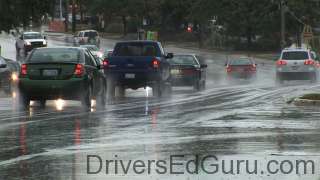Stage 4: Driving in Hazardous Conditions
Driving in snow, rain, or fog doesn’t require any “special” driving skills. It simply requires that you:
- Recognize that you are, in fact, driving in poor conditions and that you must adjust your driving behavior accordingly.
- Recognize that most of the other drivers on the road do NOT adjust their driving behavior in hazardous conditions.
If you can convince your teen of these two facts, then they’re going to be a heck of a lot safer.
When driving in hazardous conditions, remember to:
- Slow down
- Increase your following distance
- And be prepared for drivers around you to do something stupid (more often than in optimal conditions)
Rain

Wet roads are dangerous. Many drivers only think that snow is dangerous, but wet roads can be quite treacherous. Rain-slicked roads decrease your braking ability, so it takes you much further to stop than on dry roads. Even a light misting can make roads slippery as the rain mixes with the oil on the road to create a greasy surface. Of course, a heavy downpour creates the danger of hydroplaning. Hydroplaning occurs when you drive too fast on roads that are covered in water.
When hydroplaning, your tires are actually “surfing” on a thin layer of water between your tires and the road. Your tires aren’t touching the ground and thus have no traction. You can think of this as skidding forward. If you feel your car hydroplaning, slow down so that your tires can make contact with the road again. Light braking is okay, too, provided that you have anti-lock brakes.
Snow, Sleet, and Ice

Snow, sleet, and ice are extremely treacherous and should be treated with great caution. The difficulty in driving in these conditions is that each snow storm is different. Plus, as more cars drive on snow-covered roads, the conditions will change.
Hopefully, your teen’s learning process coincides with wintertime. If not, jump in the car with your teen the first time it snows. You must help point out the finer points of driving in the snow. However, like with all hazardous conditions, always err on the side of caution and slow down and increase your following distance.
- Bridges freeze before roads. This is because a bridge is in contact with freezing air from all sides. A road is only in contact with the air above it.
- You never know if there is a sheet of ice underneath the snow.
- Follow the leader: Drive in the tire tracks of other cars as there will be more traction in these areas.
- Be wary of changing lanes. Oftentimes, the area between lanes has a build-up of crunchy ice which should be avoided. If you must change lanes, do so gradually while holding the steering wheel firmly.
- All snow is different, so testing is necessary. When you first hit the road, test your brakes before you need to use them to gauge how they react to the conditions.
- Beware of black ice. Actually, the term “black ice” is misleading. The ice that forms has little-to-no air bubbles in it which makes the ice transparent. Therefore, it takes on the color of whatever is underneath it. So, on asphalt or dark-colored roads, it appears black. This black ice is extremely dangerous because it is so difficult to see. The only way you’ll know if you’ve hit a patch of black ice is that all road noise will go mute…because you’re sliding on ice. I have no advice for this other than to take your foot off both pedals and continue driving straight. Hopefully, the patch will end soon and you’ll be back on the road again.
- Stay in the right lane. There’s no need to drive quickly in snowy or icy conditions. Let the crazies spin out into the median.

Fog
If possible, driving in heavy fog should be avoided.
If you must drive in fog, make sure that you:
- Turn off your high beams and turn on your fog lights. Your high beams will actually reflect off the cloud (yes, fog is actually a cloud that is touching the ground) and bounce back into your face.
- Slow down and increase your following distance (surprised, right?)
- Since your vision is obscured, use your ears. Turn off the radio and roll down your windows and listen for cars braking, spinning out, or crashing.
- Tap your brakes prior to braking to alert the driver behind you.
- Stay in the right-most lane.
So, what’s the lesson here?
- Recognize that you’re in a hazardous driving situation.
- Slow down.
- Increase your following distance.
Continue on to Driving Off the Road (Not Off-Roading)

